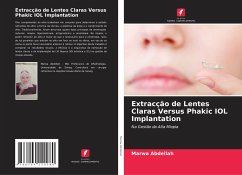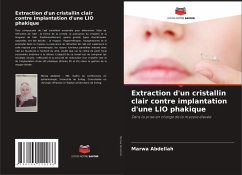
Clear Lens Extraction Versus Phakic IOL Implantation
In the Management of High Myopia
Versandkostenfrei!
Versandfertig in 6-10 Tagen
47,99 €
inkl. MwSt.

PAYBACK Punkte
24 °P sammeln!
Three components of the eye work together to determine the refractive state of the eye: the shape of the cornea, the power of the lens and the length of the eye. Traditionally, four major types of naturally occurring ametropias have been described: myopia, hyperopia, astigmatism and presbyopia In myopia, the refractive power of the eye is greater than that required for emmetropia, parrellel rays of light entering the eye in focus at the location in the vitreous, rather than on the retina (the secondary focal point anterior to the retina). The aim of this work is to compare the visual outcomes,...
Three components of the eye work together to determine the refractive state of the eye: the shape of the cornea, the power of the lens and the length of the eye. Traditionally, four major types of naturally occurring ametropias have been described: myopia, hyperopia, astigmatism and presbyopia In myopia, the refractive power of the eye is greater than that required for emmetropia, parrellel rays of light entering the eye in focus at the location in the vitreous, rather than on the retina (the secondary focal point anterior to the retina). The aim of this work is to compare the visual outcomes, efficacy and safety of clear lens extraction and phakic IOL implantation (Artisan IOl and ICL) in the management of high myopia.












